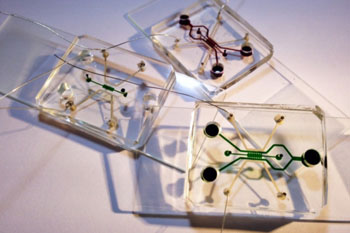Novel 3D Growth Chamber Designed for Investigating Effects of Electric Fields on Cancer
By LabMedica International staff writers
Posted on 19 Jul 2016
A team of bioengineers designed and manufactured a novel microfluidic device for use in studying the effects of an electric field on the growth and spread of cancer cells.Posted on 19 Jul 2016
A promising alternative approach to cancer therapy is based on exposing the tumor to an alternating electric field. The current study describes a device designed to facilitate research for understanding the mechanisms involved in the disruption of the cancer cell cycle by the electric field as well as any potential adverse effects on non-cancerous cells.

Image: Three microfluidic devices filled with food color dyes. The device, about the size of a credit card, is designed for the 3D growth of breast, lung, and other types of cancer cells while being exposed to an electric field (Photo courtesy of the Massachusetts Institute of Technology).
Investigators at The Singapore-MIT Alliance for Research and Technology (SMART) (Singapore) engineered a microfluidic device with embedded contactless electrodes to culture cells in the presence of an alternating electric field in a highly controlled microenvironment.
The device was fabricated from PDMS (polydimethylsiloxane), and a pattern of small channels was inscribed across its surface. A conductive mixture was prepared from micron-sized silver flakes and PDMS, and the mixture was injected into separate channels in the device to form two separate electrodes. In the region between the electrodes, it was possible to inject hydrogels - which created a three-dimensional microenvironment - containing healthy human endothelial cells or breast or lung cancer cells as well as small tumor masses. Cells growing in the three-dimensional matrix were exposed to alternating electric fields at frequencies of 150 or 200 kilohertz, continuously, at an intensity of 1.1 volts per centimeter.
To demonstrate the potential of the system for aiding in the design and testing of new therapeutic approaches, cancer cells and cancer cell aggregates were cultured individually in the device or were co-cultured with endothelial cells.
Results published in the May 24, 2016, online edition of the journal Scientific Reports revealed that the metastatic potential of the cancer cells was reduced after electric field treatment. Moreover, the proliferation rate of the treated cancer cells was lower compared with that of untreated cells, while the morphologies and proliferative capacities of the endothelial cells were not significantly affected.
“We hope this device will increase interest by researchers who are exploring the effect of electric fields on different types of cancer,” said contributing author Dr. Giulia Adriani, a research scientist at SMART. “In our study, we noticed the effect was limited to the cancer cell at the tested frequencies and intensities, but we really need to explore other cells and parameters. For personalized medicine, you can test if a recipe works for a specific person. In three days, you can have an answer. And for many cancer patients who are dying of metastasis, time is everything.”
Related Links:
Singapore-MIT Alliance for Research and Technology













